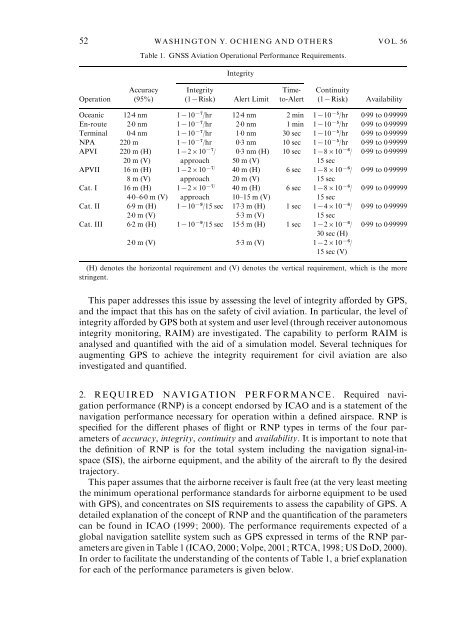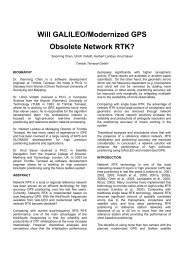GPS Integrity and Potential Impact on Aviation Safety - intelligent ...
GPS Integrity and Potential Impact on Aviation Safety - intelligent ...
GPS Integrity and Potential Impact on Aviation Safety - intelligent ...
Create successful ePaper yourself
Turn your PDF publications into a flip-book with our unique Google optimized e-Paper software.
52 WASHINGTON Y. OCHIENG AND OTHERS VOL. 56<br />
Operati<strong>on</strong><br />
Table 1. GNSS Aviati<strong>on</strong> Operati<strong>on</strong>al Performance Requirements.<br />
Accuracy<br />
(95%)<br />
<str<strong>on</strong>g>Integrity</str<strong>on</strong>g><br />
<str<strong>on</strong>g>Integrity</str<strong>on</strong>g><br />
(1xRisk) Alert Limit<br />
Timeto-Alert<br />
C<strong>on</strong>tinuity<br />
(1xRisk) Availability<br />
Oceanic 12 . 4nm 1x10 x7 /hr 12 . 4 nm 2 min 1x10 x5 /hr 0 . 99 to 0 . 99999<br />
En-route 2 . 0nm 1x10 x7 /hr 2 . 0 nm 1 min 1x10 x5 /hr 0 . 99 to 0 . 99999<br />
Terminal 0 . 4nm 1x10 x7 /hr 1 . 0 nm 30 sec 1x10 x5 /hr 0 . 99 to 0 . 99999<br />
NPA 220 m 1x10 x7 /hr 0 . 3 nm 10 sec 1x10 x5 /hr 0 . 99 to 0 . 99999<br />
APVI 220 m (H) 1x2r10 x7 / 0 . 3 nm (H) 10 sec 1x8r10 x6 / 0 . 99 to 0 . 99999<br />
20 m (V) approach 50 m (V) 15 sec<br />
APVII 16 m (H) 1x2r10 x7/ 40 m (H) 6 sec 1x8r10 x6 / 0 . 99 to 0 . 99999<br />
8 m (V) approach 20 m (V) 15 sec<br />
Cat. I 16 m (H) 1x2r10 x7/ 40 m (H) 6 sec 1x8r10 x6 / 0 . 99 to 0 . 99999<br />
4 . 0–6 . 0 m (V) approach 10–15 m (V) 15 sec<br />
Cat. II 6 . 9 m (H) 1x10 x9 /15 sec 17 . 3 m (H) 1 sec 1x4r10 x6 / 0 . 99 to 0 . 99999<br />
2 . 0 m (V) 5 . 3 m (V) 15 sec<br />
Cat. III 6 . 2 m (H) 1x10 x9 /15 sec 15 . 5 m (H) 1 sec 1x2r10 x6 / 0 . 99 to 0 . 99999<br />
30 sec (H)<br />
2 . 0 m (V) 5 . 3 m (V) 1x2r10 x6 /<br />
15 sec (V)<br />
(H) denotes the horiz<strong>on</strong>tal requirement <str<strong>on</strong>g>and</str<strong>on</strong>g> (V) denotes the vertical requirement, which is the more<br />
stringent.<br />
This paper addresses this issue by assessing the level of integrity afforded by <str<strong>on</strong>g>GPS</str<strong>on</strong>g>,<br />
<str<strong>on</strong>g>and</str<strong>on</strong>g> the impact that this has <strong>on</strong> the safety of civil aviati<strong>on</strong>. In particular, the level of<br />
integrity afforded by <str<strong>on</strong>g>GPS</str<strong>on</strong>g> both at system <str<strong>on</strong>g>and</str<strong>on</strong>g> user level (through receiver aut<strong>on</strong>omous<br />
integrity m<strong>on</strong>itoring, RAIM) are investigated. The capability to perform RAIM is<br />
analysed <str<strong>on</strong>g>and</str<strong>on</strong>g> quantified with the aid of a simulati<strong>on</strong> model. Several techniques for<br />
augmenting <str<strong>on</strong>g>GPS</str<strong>on</strong>g> to achieve the integrity requirement for civil aviati<strong>on</strong> are also<br />
investigated <str<strong>on</strong>g>and</str<strong>on</strong>g> quantified.<br />
2. REQUIRED NAVIGATION PERFORMANCE. Required navigati<strong>on</strong><br />
performance (RNP) is a c<strong>on</strong>cept endorsed by ICAO <str<strong>on</strong>g>and</str<strong>on</strong>g> is a statement of the<br />
navigati<strong>on</strong> performance necessary for operati<strong>on</strong> within a defined airspace. RNP is<br />
specified for the different phases of flight or RNP types in terms of the four parameters<br />
of accuracy, integrity, c<strong>on</strong>tinuity <str<strong>on</strong>g>and</str<strong>on</strong>g> availability. It is important to note that<br />
the definiti<strong>on</strong> of RNP is for the total system including the navigati<strong>on</strong> signal-inspace<br />
(SIS), the airborne equipment, <str<strong>on</strong>g>and</str<strong>on</strong>g> the ability of the aircraft to fly the desired<br />
trajectory.<br />
This paper assumes that the airborne receiver is fault free (at the very least meeting<br />
the minimum operati<strong>on</strong>al performance st<str<strong>on</strong>g>and</str<strong>on</strong>g>ards for airborne equipment to be used<br />
with <str<strong>on</strong>g>GPS</str<strong>on</strong>g>), <str<strong>on</strong>g>and</str<strong>on</strong>g> c<strong>on</strong>centrates <strong>on</strong> SIS requirements to assess the capability of <str<strong>on</strong>g>GPS</str<strong>on</strong>g>. A<br />
detailed explanati<strong>on</strong> of the c<strong>on</strong>cept of RNP <str<strong>on</strong>g>and</str<strong>on</strong>g> the quantificati<strong>on</strong> of the parameters<br />
can be found in ICAO (1999; 2000). The performance requirements expected of a<br />
global navigati<strong>on</strong> satellite system such as <str<strong>on</strong>g>GPS</str<strong>on</strong>g> expressed in terms of the RNP parameters<br />
are given in Table 1 (ICAO, 2000; Volpe, 2001; RTCA, 1998; US DoD, 2000).<br />
In order to facilitate the underst<str<strong>on</strong>g>and</str<strong>on</strong>g>ing of the c<strong>on</strong>tents of Table 1, a brief explanati<strong>on</strong><br />
for each of the performance parameters is given below.



